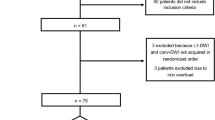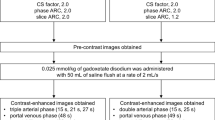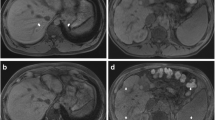Abstract
Purpose
To determine whether application of a high-acceleration parallel acquisition can provide three-dimensional (3D)-fat-suppressed T1-weighted gradient-recalled-echo (T1W-GRE) imaging at 3T for liver MR imaging.
Materials and methods
This retrospective study was approved by our institutional review board. Seventy patients underwent liver MRI at a 3T scanner. After administration of a standard dose of Gadoxetic acid for 20 min, 3D-T1W-GRE images were obtained twice using sensitivity encoding with acceleration factors (AFs) 2.6 [332 × 298 matrix, 3-mm slice thickness (ST)] and 4 (380 × 320 matrix, 1.5-mm ST). The image qualities of the two image sets were graded using a five-point scale.
Results
The high-resolution (HR) 3D-T1W-GRE image sets were obtained with an AF 4 within a single breath-hold (18.5 s). It showed a better anatomic depiction than conventional 3D-T1W-GRE image sets with an AF 2.6 (p < 0.05). Although the image noise was higher on the HR image sets (p < 0.05), the HR image sets showed better lesion conspicuity and overall image quality than the conventional image sets (p < 0.05).
Conclusion
With the use of high AFs, HR 3D-T1W-GRE imaging was demonstrated to be clinically more feasible and advantageous than the conventional 3D-T1W-GRE.




Similar content being viewed by others
References
Taouli B, Koh DM (2010) Diffusion-weighted MR imaging of the liver. Radiology 254:47–66
Elsayes KM, Narra VR, Yin Y, et al. (2005) Focal hepatic lesions: diagnostic value of enhancement pattern approach with contrast-enhanced 3D gradient-echo MR imaging. Radiographics 25:1299–1320
Kim YK, Kim CS, Chung GH, et al. (2006) Comparison of gadobenate dimeglumine-enhanced dynamic MRI and 16-MDCT for the detection of hepatocellular carcinoma. AJR Am J Roentgenol 186:149–157
Zech CJ, Grazioli L, Jonas E, et al. (2009) Health-economic evaluation of three imaging strategies in patients with suspected colorectal liver metastases: Gd-EOB-DTPA-enhanced MRI vs. extracellular contrast media-enhanced MRI and 3-phase MDCT in Germany, Italy and Sweden. Eur Radiol 19(Suppl 3):S753–S763
Kim SH, Lee J, Kim MJ, et al. (2009) Gadoxetic acid-enhanced MRI versus triple-phase MDCT for the preoperative detection of hepatocellular carcinoma. AJR Am J Roentgenol 192:1675–1681
Lee JM, Zech CJ, Bolondi L, et al. (2011) Consensus report of the 4th international forum for gadolinium-ethoxybenzyl-diethylenetriamine pentaacetic acid magnetic resonance imaging. Korean J Radiol 12:403–415
Machann J, Schlemmer HP, Schick F (2008) Technical challenges and opportunities of whole-body magnetic resonance imaging at 3T. Phys. Med. 24:63–70
Schick F (2005) Whole-body MRI at high field: technical limits and clinical potential. Eur Radiol 15:946–959
Frayne R, Goodyear BG, Dickhoff P, Lauzon ML, Sevick RJ (2003) Magnetic resonance imaging at 3.0 Tesla: challenges and advantages in clinical neurological imaging. Investig Radiol 38:385–402
Pruessmann KP, Weiger M, Scheidegger MB, Boesiger P (1999) SENSE: sensitivity encoding for fast MRI. Magn Reson Med 42:952–962
van den Brink JS, Watanabe Y, Kuhl CK, et al. (2003) Implications of SENSE MR in routine clinical practice. European J Radiol 46:3–27
Weiger M, Pruessmann KP, Boesiger P (2002) 2D SENSE for faster 3D MRI. Magn Reson Mater Phys Biol Med 14:10–19
Griswold MA, Jakob PM, Heidemann RM, et al. (2002) Generalized autocalibrating partially parallel acquisitions (GRAPPA). Magn Reson Med 47:1202–1210
Xu PJ, Yan FH, Wang JH, Lin J, Fan J (2007) Utilizing generalized autocalibrating partial parallel acquisition (GRAPPA) to achieve high-resolution contrast-enhanced MR angiography of hepatic artery: initial experience in orthotopic liver transplantation candidates. Eur J Radiol 61:507–512
Sodickson DK, Manning WJ (1997) Simultaneous acquisition of spatial harmonics (SMASH): fast imaging with radiofrequency coil arrays. Magn Reson Med 38:591–603
Carlson J, Minemura T (1993) Imaging time reduction through multiple receiver coil data acquisition and image reconstruction. Magn Reson Med 29:681–687
Seiberlich N, Breuer FA, Blaimer M, et al. (2007) Non-Cartesian data reconstruction using GRAPPA operator gridding (GROG). Magn Reson Med 58:1257–1265
Azevedo RM, de Campos RO, Ramalho M, et al. (2011) Free-breathing 3D T1-weighted gradient-echo sequence with radial data sampling in abdominal MRI: preliminary observations. AJR Am J Roentgenol 197:650–657
Gamper U, Boesiger P, Kozerke S (2008) Compressed sensing in dynamic MRI. Magn Reson Med 59:365–373
Jung H, Sung K, Nayak KS, Kim EY, Ye JC (2009) k-t FOCUSS: a general compressed sensing framework for high resolution dynamic MRI. Magn Reson Med 61:103–116
Lustig M, Donoho D, Pauly JM (2007) Sparse MRI: the application of compressed sensing for rapid MR imaging. Magn Reson Med 58:1182–1195
Mori H, Aoki S, Masumoto T, et al. (2002) Two-dimensional magnetic resonance digital subtraction angiography using array spatial sensitivity encoding techniques in the assessment of intracranial hemodynamics. Radiat Med 20:223–229
Wile GE, Leyendecker JR (2010) Magnetic resonance imaging of the liver: sequence optimization and artifacts. Magn Reson Imaging Clin N Am 18:525–547, xi
Takayama Y, Nishie A, Asayama Y, et al. (2012) Image quality of Gd-EOB-DTPA-enhanced magnetic resonance imaging of the liver using dual-source parallel radiofrequency transmission technology: comparison with the post-processing correction method for B1 inhomogeneity-induced signal loss. Eur J Radiol 81:3035–3040
Pazahr S, Fischer MA, Chuck N, et al. (2012) Liver: segment-specific Analysis of B1 Field Homogeneity at 3.0-T MR Imaging with single-source versus dual-source parallel radiofrequency excitation. Radiology 265:591–599
Rahbar H, Partridge SC, Demartini WB, et al. (2012) Improved B1 homogeneity of 3 Tesla breast MRI using dual-source parallel radiofrequency excitation. J Magn Reson Imaging 35:1222–1226
Soher BJ, Dale BM, Merkle EM (2007) A review of MR physics: 3 T versus 1.5 T. Magn Reson Imaging Clin N Am 15:277–290, v
Merkle EM, Dale BM (2006) Abdominal MRI at 3.0 T: the basics revisited. AJR Am J Roentgenol 186:1524–1532
de Zwart JA, Ledden PJ, van Gelderen P, et al. (2004) Signal-to-noise ratio and parallel imaging performance of a 16-channel receive-only brain coil array at 3.0 Tesla. Magn Reson Med 51:22–26
Dietrich O, Raya JG, Reeder SB, Reiser MF, Schoenberg SO (2007) Measurement of signal-to-noise ratios in MR images: influence of multichannel coils, parallel imaging, and reconstruction filters. J Magn Reson Imaging 26:375–385
Li C, Chen W, Beatty P, et al. (2010) SNR quantification with phased-array coils and parallel imaging for 3D-FSE. In: Proceedings of the international society of magnetic resonance in medicine, Stockholm, p 552
Gudbjartsson H, Patz S (1995) The Rician distribution of noisy MRI data. Magn Reson Med 34:910–914
Bruix J, Sherman M (2011) Management of hepatocellular carcinoma: an update. Hepatology 53:1020–1022
Zech CJ, Herrmann KA, Reiser MF, Schoenberg SO (2007) MR imaging in patients with suspected liver metastases: value of liver-specific contrast agent Gd-EOB-DTPA. Magn Reson Med Sci 6:43–52
Danet IM, Semelka RC, Leonardou P, et al. (2003) Spectrum of MRI appearances of untreated metastases of the liver. AJR Am J Roentgenol 181:809–817
Stern W, Schick F, Kopp A, et al. (2000) Dynamic MR imaging of liver metastases with Gd-EOB-DTPA. Acta Radiol 41:255–262
Reimer P, Rummeny E, Daldrup H, et al. (1997) Enhancement characteristics of liver metastases, hepatocellular carcinomas, and hemangiomas with Gd-EOB-DTPA: preliminary results with dynamic MR imaging. Eur Radiol 7:275–280
Yun E, Choi B, Han J, et al. (1999) Hepatic hemangioma: contrast-enhancement pattern during the arterial and portal venous phases of spiral CT. Abdom Imaging 24:262–266
Cooperberg P, Gibney R (1987) Imaging of the gallbladder, 1987. Radiology 163:605–613
Yarnykh VL (2007) Actual flip-angle imaging in the pulsed steady state: a method for rapid three-dimensional mapping of the transmitted radiofrequency field. Magn Reson Med 57:192–200
Possanzini C, van Liere P, Roeven H, et al. (2011) Scalability and channel independency of the digital broadband dstream architecture. In: Proceedings of the international society of magnetic resonance in medicine, Montreol, p 1893
Kang Y, Lee JM, Kim SH, Han JK, Choi BI (2012) Intrahepatic mass-forming cholangiocarcinoma: enhancement patterns on gadoxetic acid-enhanced MR images. Radiology 264:751–760
Peeters JM, Fuderer M (2013) SENSE with improved tolerance to inaccuracies in coil sensitivity maps. Magn Reson Med 69:1665–1669
Morakkabati-Spitz N, Gieseke J, Kuhl C, et al. (2006) MRI of the pelvis at 3 T: very high spatial resolution with sensitivity encoding and flip-angle sweep technique in clinically acceptable scan time. Eur Radiol 16:634–641
Vogt FM, Antoch G, Hunold P, et al. (2005) Parallel acquisition techniques for accelerated volumetric interpolated breath-hold examination magnetic resonance imaging of the upper abdomen: assessment of image quality and lesion conspicuity. J Magn Reson Imaging 21:376–382
Nael K, Ruehm SG, Michaely HJ, et al. (2006) High spatial-resolution CE-MRA of the carotid circulation with parallel imaging: comparison of image quality between 2 different acceleration factors at 3.0 Tesla. Investig Radiol 41:391–399
Zhuo J, Gullapalli RP (2006) MR artifacts, safety, and quality control. Radiographics 26:275–297
Lum DP, Busse RF, Francois CJ, et al. (2009) Increased volume of coverage for abdominal contrast-enhanced MR angiography with two-dimensional autocalibrating parallel imaging: initial experience at 3.0 Tesla. J Magn Reson Imaging 30:1093–1100
Frydrychowicz A, Jedynak AR, Kelcz F, Nagle SK, Reeder SB (2012) Gadoxetic acid-enhanced T1-weighted MR cholangiography in primary sclerosing cholangitis. J Magn Reson Imaging 36:632–640
Tanaka O, Ito H, Yamada K, et al. (2005) Higher lesion conspicuity for SENSE dynamic MRI in detecting hypervascular hepatocellular carcinoma: analysis through the measurements of liver SNR and lesion-liver CNR comparison with conventional dynamic MRI. Eur Radiol 15:2427–2434
Landis JR, Koch GG (1977) An application of hierarchical kappa-type statistics in the assessment of majority agreement among multiple observers. Biometrics 33:363–374
Porter JR, Wright SM (2001) A sixteen-channel multiplexing upgrade for single channel receivers. Magn Reson Imaging 19:1009–1016
Willinek WA, Gieseke J, Kukuk GM, et al. (2010) Dual-source parallel radiofrequency excitation body MR imaging compared with standard MR imaging at 3.0 T: initial clinical experience 1. Radiology 256:966–975
Riffel P, Attenberger UI, Kannengiesser S, et al. (2013) Highly accelerated T1-weighted abdominal imaging using 2-dimensional controlled aliasing in parallel imaging results in higher acceleration: a comparison with generalized autocalibrating partially parallel acquisitions parallel imaging. Investig Radiol 48:554–561
Hecht EM, Holland AE, Israel GM, et al. (2006) Hepatocellular carcinoma in the cirrhotic liver: gadolinium-enhanced 3D T1-weighted MR imaging as a stand-alone sequence for diagnosis. Radiology 239:438–447
Acknowledgment
The authors thank Bonnie Hami, M.A. (USA), for her editorial assistance.
Author information
Authors and Affiliations
Corresponding author
Rights and permissions
About this article
Cite this article
Yoon, J.H., Lee, J.M., Yu, M.H. et al. High-resolution T1-weighted gradient echo imaging for liver MRI using parallel imaging at high-acceleration factors. Abdom Imaging 39, 711–721 (2014). https://doi.org/10.1007/s00261-014-0099-8
Published:
Issue Date:
DOI: https://doi.org/10.1007/s00261-014-0099-8




